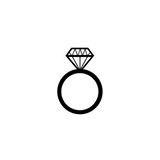What is the difference between a genuine diamond and cubic zirconia?
Although very different in other properties, cubic zirconia and diamond appear similar to a lay person because of their outer appearance and high refractive index. Fact is, diamond is a very expensive, naturally occurring substance, whereas cubic zirconia is manufactured and a less expensive jewelry substitute for diamonds. Diamond is an allotrope of carbon. It is the hardest known natural substance. Its hardness and high dispersion of light make it useful for industrial applications and jewelry. Diamonds make excellent abrasives because they can be scratched only by other diamonds. Because all these qualities and its rare natural occurrence the cost of diamonds is very high.
To substitute expensive diamonds in jewelry, a cheaper alternative was found to be Cubic zirconia as we would call it. CZ is the cubic crystalline form of zirconium dioxide(ZrO2), is a mineral that is widely synthesized for use as a diamond simulant. The synthesized material is hard, optically flawless and usually colorless, but may be made in a variety of different colors. It has close visual likeness to diamond and is relatively less expensive.
Electrical and Thermal Conductivity:
Diamonds are electric insulators and excellent thermal conductors. Cubic Zirconia are thermal insulators. Color Diamonds are generally found with a yellow or brown tinge in them, this is due to the nitrogen found in them. The color depends on the concentration of nitrogen or other such substitutes in the diamond. The really colorless diamonds are the ones which are free of any flaws and usually rare. Cubic Zirconia on the other hand being a synthesized product, can be made absolutely colorless. It can be given the grade ‘D’ which is the best quality diamond on the diamonds color grading scale.
Dispersion
Dispersion of Cubic Zirconia is higher than diamond making the prismatic fire more intense in it. Diamond dispersion is 0.044 while CZ is 0.060. Specific Gravity Cubic zirconia crystals are heavyweights in comparison to diamonds; a cubic zirconia will weigh about 1.7 times more than a diamond of equivalent size. Refractive Index The refractive index of cubic zirconia is lower than that of a diamond. It has a refractive index of 2.176, compared to a diamond’s 2.417. Cubic Zirconia is a fine alternative today to diamonds.
Flaws:
All diamonds have some kind of defect, it can be a feather, an included crystal or a remnant of an original crystal face (e.g. trigons). Cubic zirconia on the other hand are synthetic and hence are virtually flawless.
History:
Diamonds are a natural material and are thought to have been first recognized and mined in India (Golconda being one of the first places), where significant alluvial deposits of the stone could then be found along the rivers Penner, Krishna and Godavari. In the twentieth century, experts in the field of gemology have developed methods of grading diamonds and other gemstones based on the characteristics most important to their value as a gem. Four characteristics, known informally as the four Cs, are now commonly used as the basic descriptors of diamonds: these are carat, cut, color, and clarity. Cubic Zirconia is not a natural material but is a synthesized form of zirconium oxide.
Formation:
The formation of natural diamond requires very specific conditions. Diamond formation requires exposure of carbon-bearing materials to high pressure, ranging approximately between 45 and 60 kilobars, but at a comparatively low temperature range between approximately 1652–2372 °F (900–1300 °C). The depths of craters in which diamonds are formed are estimated to be in between 140–190 kilometers (90–120 miles) though sometimes it can be much more than this too. Long residence in the cratonic lithosphereallows diamond crystals to grow larger. Cubic zirconia on the other hand is a man made product. Baddeleyite was discovered in 1892, the yellowish monoclinic mineral baddeleyite is a natural form of zirconium oxide. In 1930, stabilized zirconia was obtained after stabilization of zirconium oxide had been realized. Seven years later, German mineralogists discovered naturally occurring cubic zirconia in the form of microscopic grains included in metamict zircon. As with the majority of grown diamond look-alikes, the conceptual birth of single-crystal cubic zirconia began in the minds of scientists but it was later in 1960s in France when research into controlled single-crystal growth of cubic zirconia occurred. The Soviets later perfected the method and called it skull crucible and named the jewel, fianit, though the name was not used world wide. Their breakthrough was published in 1973, and commercial production began in 1976. By 1980 annual global production had reached 50 million carats (10,000 kg). The method is still used today with some variation.
Price:
Due to the qualities of diamonds and their rarity, the cost of diamonds is very high. CZ is relatively cheaper. As a diamond simulation, CZ only has competition from the recently discovered moissanite. While a flawless 1 carat diamond would cost about $7000 or more, a flawless 1 carat CZ can be purchased for less than $10.
Production:
Gem production totals nearly 30 million carats (6,000 kg) of cut and polished stones annually, and over 100 million carats (20,000 kg) of mined diamonds are sold for industrial use each year, as are about 100,000 kg of synthesized diamond. De Beers owns or controls a significant portion of the world’s rough diamond production facilities (mines) and distribution channels for gem-quality diamonds. De Beers and its subsidiaries own mines that produce some 40 percent of annual world diamond production. At one time it was thought over 80 percent of the world’s rough diamonds passed through the Diamond Trading Company (DTC, a subsidiary of De Beers) in London, but presently the figure is estimated at less than 50 percent.
The rating system for CZ stones has been updated from when it was first discovered, helping buyer purchase high quality CZ which can hold it’s brilliance longer. To learn more read About Cubic Zirconia or email us at info@myfauxdiamond.com!













